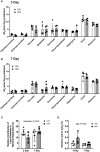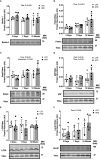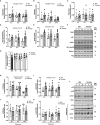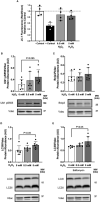Short-Term High-Fat Feeding Does Not Alter Mitochondrial Lipid Respiratory Capacity but Triggers Mitophagy Response in Skeletal Muscle of Mice
- PMID: 33868178
- PMCID: PMC8044530
- DOI: 10.3389/fendo.2021.651211
Short-Term High-Fat Feeding Does Not Alter Mitochondrial Lipid Respiratory Capacity but Triggers Mitophagy Response in Skeletal Muscle of Mice
Abstract
Lipid overload of the mitochondria is linked to the development of insulin resistance in skeletal muscle which may be a contributing factor to the progression of type 2 diabetes during obesity. The targeted degradation of mitochondria through autophagy, termed mitophagy, contributes to the mitochondrial adaptive response to changes in dietary fat. Our previous work demonstrates long-term (2-4 months) consumption of a high-fat diet increases mitochondrial lipid oxidation capacity but does not alter markers of mitophagy in mice. The purpose of this study was to investigate initial stages of mitochondrial respiratory adaptations to high-fat diet and the activation of mitophagy. C57BL/6J mice consumed either a low-fat diet (LFD, 10% fat) or high-fat diet (HFD, 60% fat) for 3 or 7 days. We measured skeletal muscle mitochondrial respiration and protein markers of mitophagy in a mitochondrial-enriched fraction of skeletal muscle. After 3 days of HFD, mice had lower lipid-supported oxidative phosphorylation alongside greater electron leak compared with the LFD group. After 7 days, there were no differences in mitochondrial respiration between diet groups. HFD mice had greater autophagosome formation potential (Beclin-1) and greater activation of mitochondrial autophagy receptors (Bnip3, p62) in isolated mitochondria, but no difference in downstream autophagosome (LC3II) or lysosome (Lamp1) abundance after both 3 and 7 days compared with the LFD groups. In cultured myotubes, palmitate treatment decreased mitochondrial membrane potential and hydrogen peroxide treatment increased accumulation of upstream mitophagy markers. We conclude that several days of high-fat feeding stimulated upstream activation of skeletal muscle mitophagy, potentially through lipid-induced oxidative stress, without downstream changes in respiration.
Keywords: autophagy; high-fat feeding; mitochondria; reactive oxygen species; respiration.
Copyright © 2021 Ehrlicher, Stierwalt, Newsom and Robinson.
Conflict of interest statement
The authors declare that the research was conducted in the absence of any commercial or financial relationships that could be construed as a potential conflict of interest.
Figures







Similar articles
-
Remodeling of skeletal muscle mitochondrial proteome with high-fat diet involves greater changes to β-oxidation than electron transfer proteins in mice.Am J Physiol Endocrinol Metab. 2018 Oct 1;315(4):E425-E434. doi: 10.1152/ajpendo.00051.2018. Epub 2018 May 29. Am J Physiol Endocrinol Metab. 2018. PMID: 29812987 Free PMC article.
-
High fat diet-induced changes in mouse muscle mitochondrial phospholipids do not impair mitochondrial respiration despite insulin resistance.PLoS One. 2011;6(11):e27274. doi: 10.1371/journal.pone.0027274. Epub 2011 Nov 28. PLoS One. 2011. PMID: 22140436 Free PMC article.
-
Sex modulates hepatic mitochondrial adaptations to high-fat diet and physical activity.Am J Physiol Endocrinol Metab. 2019 Aug 1;317(2):E298-E311. doi: 10.1152/ajpendo.00098.2019. Epub 2019 Apr 30. Am J Physiol Endocrinol Metab. 2019. PMID: 31039007 Free PMC article.
-
Cytosolic lipid excess-induced mitochondrial dysfunction is the cause or effect of high fat diet-induced skeletal muscle insulin resistance: a molecular insight.Mol Biol Rep. 2019 Feb;46(1):957-963. doi: 10.1007/s11033-018-4551-7. Epub 2018 Dec 8. Mol Biol Rep. 2019. PMID: 30535784 Review.
-
Mechanisms and Physiological Roles of Mitophagy in Yeast.Mol Cells. 2018 Jan 31;41(1):35-44. doi: 10.14348/molcells.2018.2214. Epub 2018 Jan 23. Mol Cells. 2018. PMID: 29370687 Free PMC article. Review.
Cited by
-
Insights into the development of insulin resistance: Unraveling the interaction of physical inactivity, lipid metabolism and mitochondrial biology.Front Physiol. 2023 Apr 20;14:1151389. doi: 10.3389/fphys.2023.1151389. eCollection 2023. Front Physiol. 2023. PMID: 37153211 Free PMC article. Review.
-
Mitochondrial Dysfunction, Oxidative Stress, and Inter-Organ Miscommunications in T2D Progression.Int J Mol Sci. 2024 Jan 25;25(3):1504. doi: 10.3390/ijms25031504. Int J Mol Sci. 2024. PMID: 38338783 Free PMC article. Review.
-
Mitochondria as a target for exercise-mitigated type 2 diabetes.J Mol Histol. 2023 Dec;54(6):543-557. doi: 10.1007/s10735-023-10158-1. Epub 2023 Oct 24. J Mol Histol. 2023. PMID: 37874501 Review.
-
Dysfunctional Mitochondria Clearance in Situ: Mitophagy in Obesity and Diabetes-Associated Cardiometabolic Diseases.Diabetes Metab J. 2024 Jul;48(4):503-517. doi: 10.4093/dmj.2023.0213. Epub 2024 Feb 15. Diabetes Metab J. 2024. PMID: 38356350 Free PMC article. Review.
-
Muscle miR-16 deletion results in impaired insulin sensitivity and contractile function in a sex-dependent manner.Am J Physiol Endocrinol Metab. 2022 Mar 1;322(3):E278-E292. doi: 10.1152/ajpendo.00333.2021. Epub 2022 Jan 24. Am J Physiol Endocrinol Metab. 2022. PMID: 35068192 Free PMC article.
References
Publication types
MeSH terms
Substances
Grants and funding
LinkOut - more resources
Full Text Sources
Other Literature Sources
Miscellaneous

